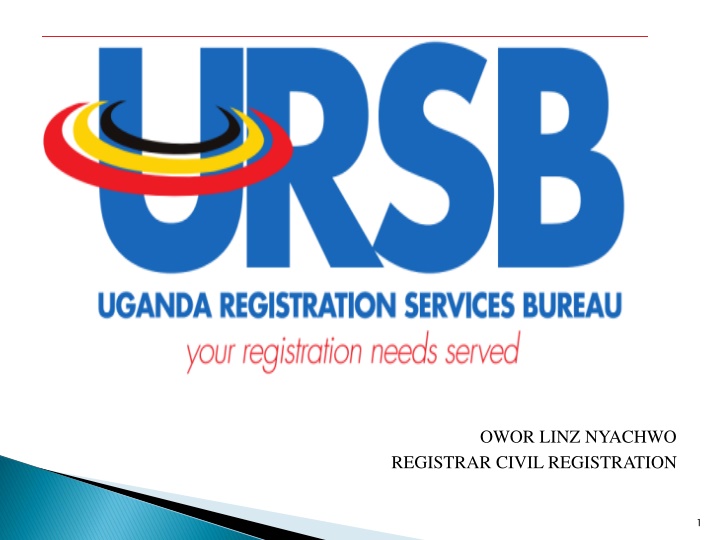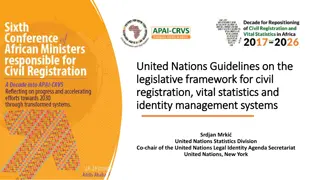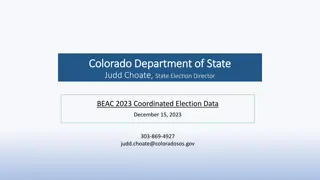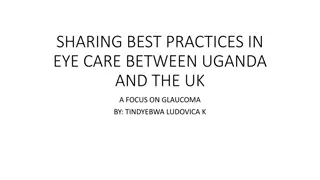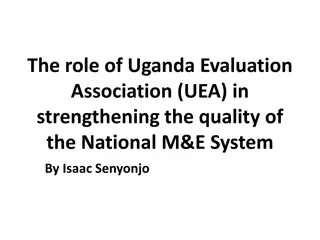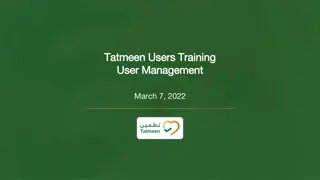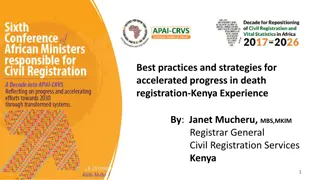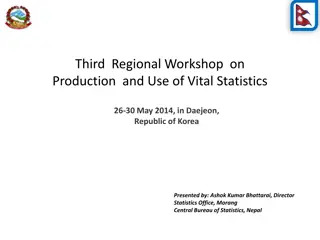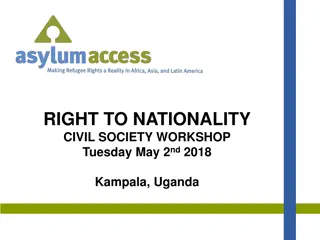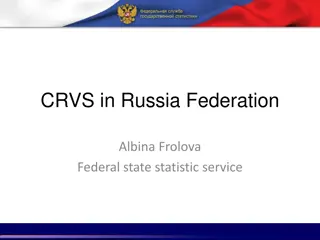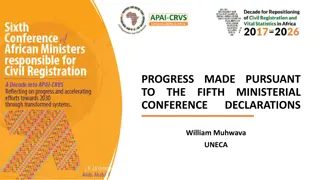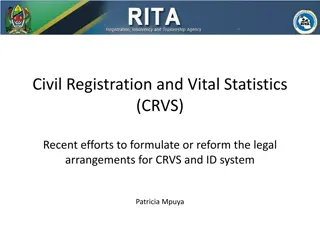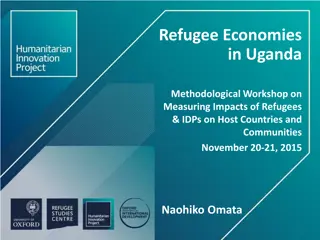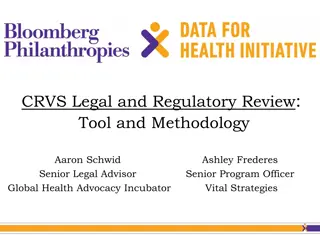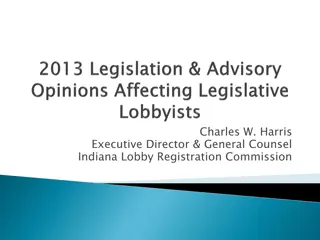Civil Registration System in Uganda: Legal Framework and Responsibilities
The civil registration system in Uganda is governed by a legal framework including the Constitution, Registration Services Bureau Act, Children Act, and other laws. The Uganda Registration Services Bureau oversees the registration of vital events such as births, deaths, marriages, and adoptions. Registrars appointed by the Attorney General manage registration districts and issue certificates. District offices, hospitals, and health centers play key roles in recording and maintaining birth and death records. The system ensures accurate documentation of vital events for legal and statistical purposes.
Uploaded on Sep 17, 2024 | 8 Views
Download Presentation

Please find below an Image/Link to download the presentation.
The content on the website is provided AS IS for your information and personal use only. It may not be sold, licensed, or shared on other websites without obtaining consent from the author.If you encounter any issues during the download, it is possible that the publisher has removed the file from their server.
You are allowed to download the files provided on this website for personal or commercial use, subject to the condition that they are used lawfully. All files are the property of their respective owners.
The content on the website is provided AS IS for your information and personal use only. It may not be sold, licensed, or shared on other websites without obtaining consent from the author.
E N D
Presentation Transcript
OWOR LINZ NYACHWO REGISTRAR CIVIL REGISTRATION 1
Overview Legal regime Births and Deaths (Institutional framework, roles and responsibilities) Marriages (Institutional framework, roles and responsibilities) Adoptions Challenges 2
What is civil registration o Official recording of vital civil events by the government. oEvents include births, deaths, marriages and adoption. oMandate of Uganda Registration Services Bureau (URSB) Civil Registration at URSB is the mandate of the Directorate of Civil Registration. 3
Legal and Institutional Framework Relevant laws Constitution of the Republic of Uganda, 1995, Article 18 Uganda Registration Services Bureau Act, Laws of Uganda Chapter 210 Children Act Local Governments Act, 1997, Part 2, Clause 14 Birth and Death Registration Act, 1973 Marriage Act (Cap 251) The State shall register every death occurring in Uganda Constitution of the Republic of Uganda, Article 18 every birth, marriage and The Uganda Registration Services Bureau is an autonomous statutory body with the mandate to carry out all registrations required under the laws of Uganda. URSB Act, Laws of Uganda Chapter 210 autonomous statutory body Registration Districts: 135 Government, Missionary and Industrial Hospitals, 1,350 S/Cs, T/Cs and Divisions Municipalities The City of Kampala 218 HCIVs have been gazetted as registration districts 4
Hon. Minister for Justice and Constitutional Affairs Policy formulation Attorney General: Appoints Registrars and designates registration districts Registrar General: Issues long birth and death certificates Receives returns from districts and hospitals Issues registration materials to all registration Districts Certification of documents in his custody Collects Non Tax Revenue (NTR) on behalf of Gov t; 5
CAOs/District Headquarters Forward returns to Registrar General Sub County/Kampala Capital City Authority/Town Council/Hospital/Health Centre IVs Register births and deaths and maintain records thereof Collect NTR Forward returns to the Chief Administrative Officer for onward transmission to the Registrar General. 6
a) Births and Deaths The 1995 Constitution of the Republic of Uganda and the 1997 Local Government Act as amended brought in decentralization. As such, activities in the BDR campaign follow a national harmonized model of birth and death registration. 7
INSTITUTIONS Ministry of Finance Ministry of Health Ministry of Justice / Attorney General National/ Regional Referral Hospitals Uganda Bureau of Statistics URSB BDR National Task Force Government, Missionary and Industrial Hospitals District Local Governments Parish Sub counties/ Town Councils/ Municipalities, Health Centre IVs Village Notifiers 8
Context of Uganda Context of Uganda Population: 34.9 million Annual number of births: 1,514,000 Deaths: 76 deaths per 1000 57% of children are born within heath facilities (UDHS 2011) Only 30% of children are registered at birth Source: UDHS 2011 - OBOS 9
The Statistics; 579,592 new births registered in the FY 2013/14 up from 258,206 new births FY 2012/13 135 Hospitals were trained and equipped to use mobile VRS in FY 2013/14 up from 3 in FY 2012/13. 67 Sub counties registering using Mobile Phones. 33 districts using Mobile Registration including all 5 KCCA Divisions. With increased funding this can be replicated in all 112 districts Improved service delivery: 2 days to produce a long birth certificate from 18- 25 days. Birth Registration Statistics for Financial Year 2013/2014 10
Country wide campaign for Civil Registration Don t be a Nobody ; Register your birth Today! -Hospital based registration. -Phone/ kiosk based registration for community/ hard to reach areas. -Working with local government structures led by District officials using Mobile phones and NSIS equipment at sub counties. -Working with Early Child Development (ECD) centres Schools &Universities. -Linking marriages to BDR record using the Unique Identifier number. -Linking Adoption registration to CR and NSIS data 11
Strategies for Intervention Strategies for Intervention The CRVS Countrywide Assessment to establish the Baseline indicators on Civil Registration Status in Uganda, is in the final stages. Training and equipping of 8,889 Civil Registration officials in 112 Districts of Uganda. A Mobile VRS Review and BDR Policy development are in the pipeline, Conducting media awareness raising campaigns to influence positive thinking and attitudes towards Civil Registration Capacity building for partners e.g. computerisation and automation of processes at the sub national level Computerising and equipping the Central Registry. Involve wide mobilization of stakeholders for utilization of BDR data (NSSF, Banks, Social Protection etc Activating death registration and cause of death reporting, Legislative reform 12
The Bill seeks to among others; Establish the National Identification and Registration Authority. Once passed into law, the Authority will take over the functions of the Registrar of Births and Deaths. This implies that Civil registration will again be scattered as different institutions will have different functions in civil registration. 13
a) Forms of Marriages recognized in Uganda b) The Christian/ church marriage c) The Civil marriage (By the Registrar of Marriages) d) Customary marriage e) Hindu marriage f) Islamic marriage 14
1. Marriage under the Marriage Act Cap 251, Laws of Uganda Christian/ church marriages Celebrated according to the rites and customs of the various Christian religions Civil marriages . Celebratedat the offices of the Registrar of Marriages by the Registrar of Marriages; that is the Registrar General and the Chief Administrative Officers of the various districts a) a) 15
2. Customary marriages Celebrated according to the rites and customs of the parties 3. Hindu marriages Celebrated according to the rites and customs of the parties. Both parties must profess the Hindu religion. 4. Islamic marriages Celebrated according to the rites and customs of the Islamic faith. Both parties must be of Muslim religion. 16
Hon. Minister for Justice and Constitutional Affairs Hon. Attorney General Uganda Registration Services Bureau Sub county Chiefs,Town clerks Chief Administrative Officers Places of public worship licensed to celebrate marriages Mosques Temples 17
Hon. Minister for Justice and Constitutional Affairs. Grants licenses. -Dispensing with given provisions of the Law -Places of public worship to celebrate marriages On advise of the Registrar General, provides the fees for marriages under the various Laws. Issues statutory instruments as provided for under the various Laws. 2. Hon. Attorney General. Divides the country into registration districts for purposes of marriages. Appoints marriage registrars. 1. 18
Registrar General Celebrates Civil marriages and issuance of certificates thereof. Repository for marriage registration data. Collection of Non Tax Revenue (NTR) Search, certification and Verification of documents Provide Advisory services to Government. Chief Administrative Officers Celebrate civil marriages in the various districts Collect NTR Forward marriage returns to Registrar General. 19
Sub County Chiefs/Town Clerks Register customary marriages and issue certificates of customary marriage registration Forward returns of customary marriages registered to the Registrar General Collect NTR. Churches/Temples/Mosques Celebrate marriages in accordance with their respective rites and customs Forward monthly returns to the Registrar General for custody 20
The Registrar of Births and Deaths, who is the Registrar General is mandated by the Children Act to maintain an adopted children's register where particulars of adoption orders are entered. the Registrar General therefore registers adoption orders and issues certificates of adoption. 21
Divorces are handled by the Judiciary. There is no provision for registration of divorces save for the Muslim Divorces which are registered by the Registrar General as provided under Cap 252. There is a Marriage and Divorce Bill before which seeks among others to have all divorces registered by the Registrar of Marriages 22
Financial constraints Absence of a BDR Policy. This has in turn hindered reform of the BDR Act. Lack of awareness both by the public and the various duty bearers. Limited coverage Archaic civil registration laws eg, Marriage Act 1904 Births and death registration Act 1973 23
